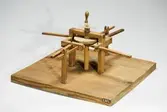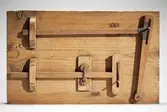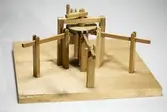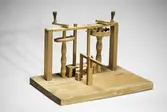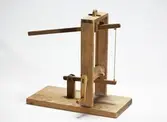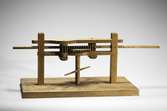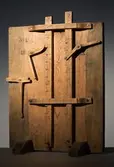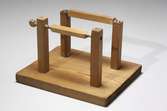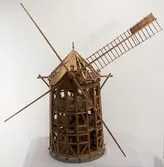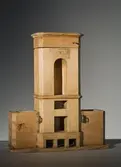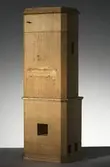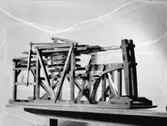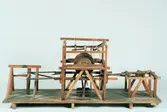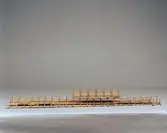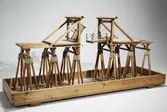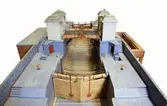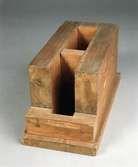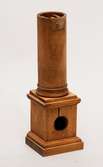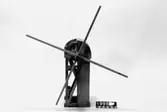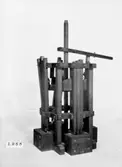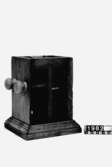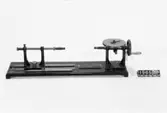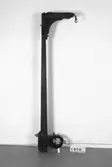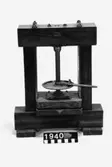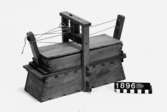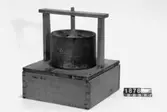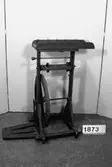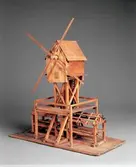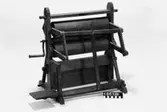
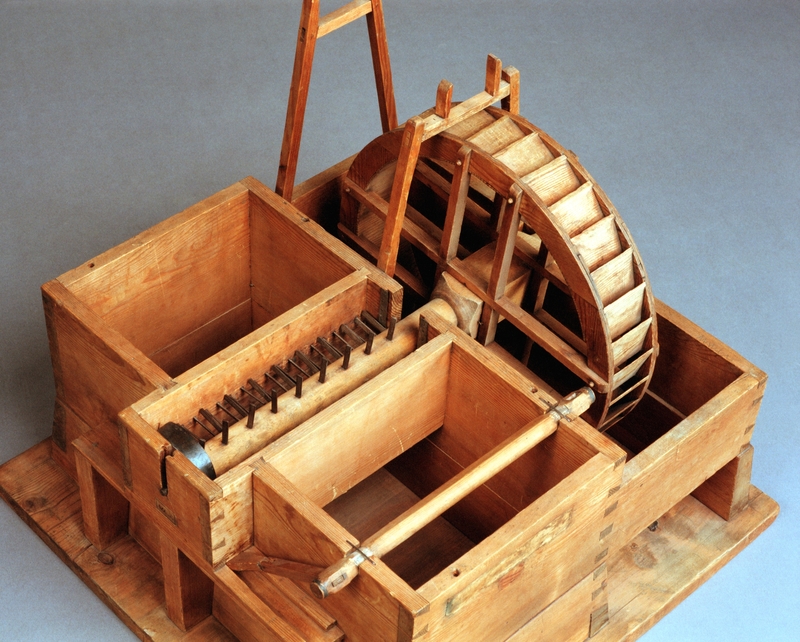
Royal Model Chamber
The Royal Model Chamber was the official name of the collection of models famous throughout Europe which from 1757 to 1802 could be seen in the so-called Rikssalen and in adjacent rooms in the Royal Palace on Riddarholmen, Stockholm. Its history goes back to the Laboratorium Mechanicum which was established in 1697 on Kungsholmen, Stockholm under the supervision of Christopher Polhem and which from 1701 to 1735 was attached to his manufacturing works in Stjärnsund.
The collection has been moved several times, exposed to fire and stored in inadequate premises. In 1826 the collection was held by the Technological Institute and from 1876 by the Royal Institute of Technology, where it fell into oblivion. In 1925, the Technical Museum took care of what remained and began renovating and conserving the objects. Today, the collection consists of 424 items, including the so-called Mechanical Alphabet.
The content of the model collection has changed over the years. We have chosen to show the collection as it looked in 1779. At this time, the director of the model chamber, Jonas Norberg, made a list called "Inventory of the Machines and Models, which are at the Royal Model Chamber in Stockholm, located in the old Royal House on K. Riddarholmen." In this list, all models exhibited at the time are described and divided into six sections, see the link to subsections. In addition to these departments, there was also Christopher Polhem's completed Mechanical Alphabet, which consisted of 32 models.
In connection with the 1779 inventory, several models were excluded that were not found to be "Mechanical, and thus had been handed over to other Publique Works, and were considered useless and not worth including here". Of the 212 models that, apart from the Mechanical Alphabet, were on display, 134 had been newly manufactured, while 78 were derived from previous lineups. Of the 78, 58 were attributed to Christopher Polhem. Which of these remains in the museum's collection today is, however, largely unknown.
In several rounds, the model chamber was later supplemented with far more models than those in the 1779 version. During the 19th century, when the collection formed a natural part of the teaching at the Technological Institute, a larger amount of models representing different types of movement conversion of the same type were added like those in the Mechanical Alphabet. These models were often different forms of student work at school. All the models which in the museum's collection are classified as belonging to the Royal Model Chamber but which have not already been described before, can be found in the subsection "Other models".
We have quoted from Norberg's list but modernized the expressions.
Polhem's mechanical alphabet
The prototypes for the vast majority of models were Polhem's own. He then let some skilled modeler realize the ideas. They formed an essential part of the "Laboratorium Mechanicum" that Polhem himself presided over from 1697, first on Kungsholmen and from 1701 on Stjärnsund. The institution functioned as an educational institution and an experimental workshop. Already in the 1860s, Olof Rudbeck had run a similar institution in Uppsala but was denied state support for the operation. In 1685, the physician and natural scientist Urban Hjärne had received permission to set up a "Laboratorium Chymicum" to produce medicines and test medicinal plants there. Inspired by these activities and with impulses from his travels in Europe in 1694-1696, Polhem thus succeeded in getting King Charles XII to establish the "Laboratorium Mechanicum" in 1697.
In 1729, the later famous student of Polhem, Carl Johan Cronstedt, described the usefulness of such a collection: "As necessary as it is for a book mind, to be able to promptly remember all the words required to compose a sentence and writing, it is also as necessary for a Mechanicus to have all simple movements familiar and promptly remembered..."
Cronstedt depicted 103 "letters" in a sketchbook in 1729, of which 38 are described in more detail.
In 1779, when the alphabet was included as part of the "Kongliga modellkammaren", the superintendent Jonas Norberg wrote the following: "all familiar simple motions to the number of 80 pieces, young Mechanicis to a strange relief, when they are at a loss as to the power or motion which may be most conveniently applied to their Mechanical Inventions."
In the museum's collection, 32 models of the 80 "letters" that were exhibited in 1779 remain. Several of them have been depicted in 3D.
The museum's selection:
Models for agriculture
The first department consisted of models for agriculture and in turn this department was divided into 10 groups. In 1779, there were 43 models in the department, but today only 10 of these remain. The 10 groups were:
- "Farming Tools" (8/0)
- "Buildings for the preservation of unthreshed grain in moisture"(6/1)
- "Thresher Machine" (5/1)
- "Machines for Seed Throwing and Sorting" (3/2)
- "Model for the breaking up and removal of stones from fields and meadows" (2/1)
- "Grain Magazines" (2/0)
- "Hacking Machines" (4/1)
- "Malt and drying house, built together" (3/1)
- "Drying house for every kind of seed drying" (4/0)
- "Weather mills" 6/3)
The numbers in parentheses refer to the original number/current number.
The museum's selection:
Construction of fireplaces for saving wood
The second department consisted of 29 models, of which 20 are preserved in the collection. The items missing are a model of a stove with a baking oven, 5 models of different types of tile ovens, a model of a "Dye Pans" (?) plant, and a furnace for heating iron plates that would be used in pressing clothes and cloth.
Several of the tile stove models are made from drawings by Carl Johan Cronstedt, who died two years before the inventory was made. Cronstedt was the man who invented the Swedish tiled stove. Cronstedt wrote:
"All previous Inventions of fireplaces, although different in one way or another, are nonetheless based on a single principle, which is that by means of fire and smoke leading several detours, profit from all possible heat, before the same escapes into the open air."
"The public is now so convinced of its benefits that the previous bottom tile stoves are mostly abandoned. Less wealthy home owners, preferably in the country where tiles and tile stove makers are not always available, can have their tiled stoves made of bricks installed by handy masons, which become quite attractive when they are carefully built with neat joints, sanded smooth with bricks dipped in water, whitewashed, lined in squares like tiles, and painted with flowers or other useful decorations."
The museum's selection:
Establishments at mines and other works powered by water
In the Third Department, half of the original number of models remain from the 1779 exhibition. They were divided into three groups.
- "Ore raising Works" (19/6)
- "Several other Machines belonging to the mining industry" (11/5)
- "Several other Works powered by water" (9/4)
The numbers in parentheses refer to the original number/current number.
The museum's selection:
Machines for factories and crafts
The fourth department was divided into factory machines and machines for "all kinds of manual work". 10 of the original 24 factory machine models from the 1779 exhibition remain, while 6 models for "every kind of handwork" remain of the original 10.
The museum's selection:
Locks, bridges, dams and other water structures
The fifth division was divided into the groups:
- "Sluices, and to their building belonging Machines" (5/4)
- "Bridges" (4/2)
- "Hold-Embankments"(2/1)
- "Pile cranes and lifting gear for lifting piles" (5/1)
- "Several other Water Buildings" (19/10)
The numbers in parentheses refer to the original number/current number.
The museum's selection:
Several buildings and their associated amenities
In the sixth department, only about 20 percent of the original models remain in the collection. The department was divided into was divided into:
- "Church steeple, Lighthouses, etc." (11/0)
- "Experiment Machines in Physics" (4/0)
- "Several Household Appliances, Machines and Inventions" 19/5)
- "Housewares" (8/4)
The numbers in parentheses refer to the original number/current number. Among the models that are missing were i.a. a "Model of an ordinary bed with the improvement that no wall vermin can get into it, as long as it does not happen with other contaminated bedding".
The museum's selection:
Later models
In this section are the models that were not exhibited in 1779. There are those that were in earlier versions of the Royal Model Room, but the vast majority were added after 1779. Many were manufactured at the Technological Institute, later the Royal Institute of Technology (KTH). The tradition of understanding and illustrating mechanics by making models continued for a long time.
In this section there are far more models than the ones we have selected.
The museum's selection:

